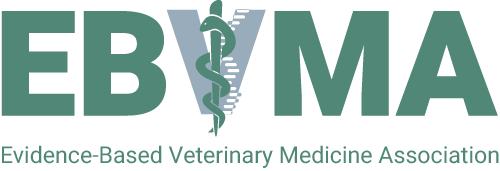Dear EBVMA members,
I feel fortunate to be President of the EBVMA during its 20-year anniversary and have many other colleagues to thank for helping to create and keep the EBMVA alive. The current EBVMA, all-volunteer, Board devotes countless hours every month to the organization. It is their vision, creativity and motivation that has allowed the organization to develop and pursue initiatives that should make the organization even more relevant and exciting in the future. An ever- improving website, initiatives such as an EBVMA Journal Club, a partnership with VetPrescriber, a resource that critically evaluates drug claims made by pharmaceutical companies, and a collaboration with VIN where experts take on some of the most asked clinical question on VIN message boards are all in the works. Our bimonthly Vet Practice News articles have been well received and cover a wide range of clinically relevant topics.
Like many of you, I have often found evidence-based medicine to be inextricably linked to statistical competencies that I was never taught in vet school or during my residency. Despite my attempts to fill this gap in my knowledge base, I often found myself glossing over the stats information in the materials and methods sections of veterinary journal articles, believing I had no way of knowing whether the authors appropriately utilized the Kruskal-Wallis test or Bonferroni correction. Until getting more involved in the EBMVA I simply assumed that any paper published in a peer-reviewed journal was, by definition, free of design, execution, and interpretation errors, as there was no chance that reviewers and editors would allow a flawed manuscript to get past their screening processes. While ignorance may have been bliss, I now know that these assumptions were, unfortunately, incorrect. However, one need not be a PhD statistician or epidemiologist to make some conclusions about the methodology used in scientific papers, and the EBVMA is an excellent resource for providing basic but important tools for ensuring that the information and conclusions in the studies you are reading actually support their claims. Examples of useful resources on the EBVMA website include our “Evidence Anxiety Series” podcasts, as well as a range of links for practitioners to help them practice EBVM. I encourage members to check out these and other resources at https://ebvma.wildapricot.org/ebvma-resources.
You all should have previously received our updated “rebranding letter” that noted the expanded efforts of the EBVMA to take on the issue of how sources of information get filtered
through other sources - advertisements, online webinars, drug reps, conference speakers, etc. - that can intentionally or unintentionally modify the information to fit their own narratives or goals, leaving practitioners trying to sort through confusing or conflicting information.
With active growth of the EBVMA will come growing pains. However, one of the best salves for these pains is to encourage members to get involved and contribute a little bit of time to the organization. Whether that means participating in the upcoming journal club initiative, offering to write an article for Vet Practice News, or volunteering for a committee or Board position, member engagement will help keep the momentum we have created moving forward. If you are interested in volunteer opportunities, please don’t hesitate to reach out to me at GBYLC@AOL.com or our Executive Secretary, Dr. Thomas Doker at info@EBVM.org. Thank you for your continued support.
Gary Block DVM, MS, DACVIM President EBVMA
